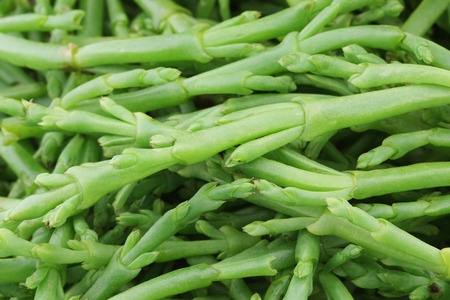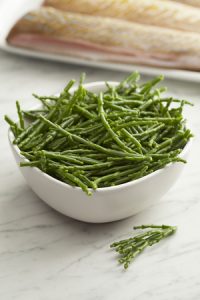
Samphire comes as two species – the marsh (Salicornia europea) and rock forms. Both are hardy perennials which are salt-tolerant too and are found growing along coastal habitats mostly throughout Europe, the Mediterranean region and North Africa. ! Marsh Samphire tends to be found on coastal mud flats, in estuaries and salt marshes.
Samphire is a gourmet delicacy !
Marsh samphire is said to look like baby asparagus which is suggested by its bright, vibrant green stems. It grows as a prostrate, low-growing plant no higher than 40 cm with slightly succulent, aromatic, even spicy leaves. It has a salty, crisp taste which can be used raw in salads if it is run under plenty of water but is often lightly boiled or steamed and sautéed to remove that overly salty flavour. Rock samphire apparently has a more unpleasant smell and flavour but is used nonetheless in gourmet dishes to complement fish and other seafood.
The plants are tolerant of most soils as long as good drainage is provided and there is no free standing water about. It tends to be a good herb for the rock garden or container.
Rock Samphire was and is still grown as a culinary pickling herb and relish from the seventeenth and eighteenth centuries onwards. It was prescribed by herbalists as a diuretic and food to calm the intestine. In Mallorca, it is often used as part of a tapas where seafoods are presented.

Sowing Samphire Seeds
Seed is best sown in Autumn or early Spring in seed trays, plugs and pots. It needs a high quality seed compost such as John Innes No. 1 with equal parts of horticultural sand to provide good, rapid draining. It needs covering throughout the Winter in the UK and is best kept in a cold frame where a cool, even Winter temperature of just below 10 C is maintained until germination. This often takes up to 2 weeks.
Following germination, the young plantlets are kept moist not wet. Seedlings are pricked out when the first true two leaves appear and then transplanted into small pots with a loam-based soil containing horticultural grit to maintain and improve drainage.
Any Autumn grown plants are over-wintered in frost-free conditions before planting out. Young plants are spread out 30cm apart in Spring. They should be allowed to grow in a sheltered site which is sunny with free-draining soil. Grit and sand should be added to heavy loam or clay to encourage removal of water rapidly or simply planting into well-drained containers of gritty loam.
Continuing Care (Aftercare)
Few pests are reported but roots will rot if left soaking in water or poorly-drained soil. The crown deserves winter protection but once established will thrive unless over picked. Straw is often used as bedding to allow air to circulate and prevent crown rot in any damp, cold conditions. Established plants are divided in Spring by digging the plant up fully, dividing the crown and replanting in new positions.
Harvesting
Pick the young leaves in Spring and early Summer by hand rather than cutting. Only the juiciest leaves should be used. Older foliage is too woody for the dinner table. It is really best eaten in July and August.



We want to find a supplier of this plant. Know anybody who does it ?
Try Suttons